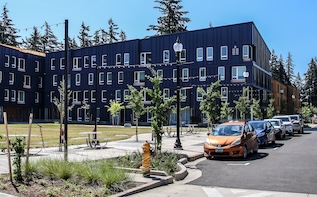- Home
- About Gresham
- Gresham History
About Gresham
Gresham History
Gresham is located on the traditional territory of the Chinookan peoples, who hunted in the then-heavily forested Johnson Creek watershed and fished in Johnson Creek.
Gresham elected its first mayor and city council in 1904. Permission to incorporate Gresham was granted by the state on Feb. 11, 1905.
Early history
Prior to the arrival of early pioneer settlers, the Clackamas tribe of the Chinookan peoples built their plank-house villages next to the various creeks and rivers within Gresham.
The lure of land enticed European settlers to what would later be known as Gresham. Before 1884, Gresham was known to many as Camp Ground or Powell's Valley, after one of the first pioneer families that settled in the area.
-
The Clackamas were skilled craftspeople who produced canoes, clothing, basketry and tools, and traded with other tribes.
-
Workers sorting strawberries at the Gresham Berry Growers Cannery. Gresham was once known as the “Raspberry Capital of the World.” The growing and processing of berries commercially began in 1914.
-
Donahue and Kelly Logging Co., Powell Valley Road circa 1890. Logging was an integral part of the early local economy. Cutting was done by hand, using oxen and horses to transport logs to local sawmills.
-
Cedarville Confectionery circa 1900. In the late 1890s, the Forbes family built the confectionery near Linnemann Junction; it sold ice cream, candy, groceries and feed for livestock.
-
The Gresham Outlook was founded in March 1911 by H.L. St. Clair. It was a family business. St. Clair’s daughter named it, his son was the editor and his wife was reporter, proofreader and kept the books.
-
Fires that consumed buildings and whole city blocks led to the formation of a volunteer fire department in 1910. The first paid firefighter was hired in 1967.
-
Sterling & Johnson Hardware Store circa 1911. The store, located on Main Avenue was one of Gresham’s earliest businesses. The store changed ownership several times, but remained a hardware store until 1982
-
Gravel deposits in local soil provided construction materials. Gravel was used in paving early roads, and was excavated by hand and hauled by horse and wagon. This early gravel pit was located near what is now known as Farris Road.
-
The interior of the A.W. Metzger Store in 1918. Several Metzger family members were early settlers of Gresham. Their grocery store, at Roberts Street and Powell Boulevard, offered canned goods, fruits and vegetables and provided lunches.
-
The Thayer Berry Box Factory produced crates and boxes for local berry growers. Photo circa 1929.
-
Gresham Fire Department First Aid Car circa 1938. The car was selected by the Federal Bureau of Investigation as the official first aid car that accompanied President Franklin D. Roosevelt on his 1938 visit to Works Project Administration (WPA) projects in Oregon.
Historic landmarks
The City maintains a list of sites and structures that have achieved the honor of being placed on Gresham’s Historic and Cultural Landmarks List. These properties have retained their historic character, serve as a past record of a certain time, place and use, and are often associated with a historical figure, event, building designer or architectural style.
-
Gresham's most recent inclusion on the National Register of Historic Places in June 2016 was prepared by the Historic Resources Subcommittee.
Charles Hunter Hamlin built this unique Gothic Revival home in 1888. Hamlin was the engineer on the first steam ship to navigate up the Willamette River through the Willamette Falls Locks in 1878. The Reverend Jonas Johnson, a leader in Gresham’s Swedish immigrant farm community, purchased the home in 1903.
-
The Zimmerman House has history back to the pioneer resettlement in Oregon Territory. In 1869, Jacob Zimmerman, a German immigrant, purchased a 320-acre donation land claim and built this house in 1874. One of the first pioneer families in the Gresham/Fairview area, the Zimmerman family lived in this home until 1992. Now a museum, the home continues to tell the Zimmerman’s story.
-
This is Gresham’s first public library. Before the Carnegie Foundation donated the funds to build it in 1913, local residents had to travel to Portland to visit a library. Gresham citizens led a coordinated effort to bring a library to the city, and this building represents their hard work.
-
This is a mail-order home. In about 1900, William Gedamke, a Gresham farmer, purchased the plans for the home from The Cottage Souvenir No. 2. He logged the area and used the timber to build the home.
-
The Louise Home represents a time in U.S. society when governments did not offer social services. The home, designed in 1925 by Architect Carl H. Walworth, was part of an extensive 17-acre farm and wooded campus for unwed mothers, which private philanthropists and religious organizations funded.
-
This home represents the lives of two important Gresham residents. Local Gresham builder Charles E. Witter built the Queen Anne style home in 1906. Emanuel Anderson, a leader in the Gresham Saron Lutheran Church and Emanuel Hospital in Portland, lived here.
-
A woman with extensive land holdings, Hannah (Rilla) Heiney owned this home, built by her family in 1910. Hannah’s husband, Franklin, owned and operated a sawmill on Butler Creek with his brothers. The Heiney family was regularly in the local news, often entangled in controversy.
-
This is one couple’s dream home. Charles and Fae Olsen designed this home though correspondence while Charles was overseas during World War II. When he returned, the couple built their modern dream home using locally milled lumber and careful resourcefulness. Along the way, they kept meticulous records and receipts, which allows us a snapshot into their dream and how they created it.
-
This home is associated with Bernard Witter, a German immigrant and early settler of Gresham. In the early days of Gresham, Witter and his sons were some of Gresham’s most prolific homebuilders.
-
Built in 1923, West Gresham Grade School marked a significant switch from dispersed one-room schoolhouses to a centralized consolidated school district. The school symbolizes the community’s growth from a farming community to a city.
-
This 1908 home is associated with Rev. Dr. Alfred Thompson, a pastor in the Gresham Methodist Church. Rev. Thompson not only helped secure the land for the 1908 Linneman Memorial Methodist Episcopal Church, he financed the church and his retirement through selling lots on a large piece of property called Thompson’s Addition.
-
This is one of Gresham’s oldest homes and it stayed in the same family for generations. John F. Roberts, a young Oregon Trail child, built part of this home in 1868. The home is associated with his descendants too, members of the Roberts, Hodge, and Powers families.
-
This home represents the influence of urban transportation in Gresham. Alfred J. Stout, a local farmer, built this home in 1902. Just a few years later, Stout clashed with the Springwater interurban line for cutting through his farm. By the 1920s, Stout moved away and the area became vacation homes and gardens for elite Portland families, who commuted out on the Springwater line.
-
An Irish immigrant carpenter named William King Hamilton built this house in 1922. One of the first houses in the neighborhood, the home is of a high quality craftsmanship often seen in the work of early immigrant carpenters in Gresham. At the same time, homes like this were attainable and affordable for workers like Hamilton.
-
Emmitt H. Kelly built this home, one of the first in the Zenith Addition, in 1913. The son of Oregon Trail pioneers, he held a variety of jobs in Gresham, but his most successful was real estate development and home building.
-
Dr. Hubert H. Hughes lived in this home from 1922 to 1964. He was a respected physician and longtime mayor of Gresham most noted for helping the city grow to meet the need of returning veterans after Word War II.
-
This 1913 home represents the life of Judge George W. Stapleton, an important leader who lived in Gresham but worked in Portland. A Multnomah County Circuit Judge and former Gresham Mayor, George W. Stapleton was involved with many civic institutions in Gresham and the county.
-
The William Peterson House, built in 1909, represents rural life just outside the city and the development of Gresham’s berry growing and processing industry. A founding member of the Gresham Fruit Growers Association, Peterson helped make the city the “raspberry capital of the world.”
-
Constructed in 1906, the William Fredrick Honey House is one of the first large homes in the Northwest Neighborhood. The Honey family moved to Gresham from North Dakota and their home embodies the booming real estate market of the 1900s that attracted farmers to live in the city.
-
This home was constructed by Arthur Fieldhouse and his family in 1905. Local builders, merchants, and real estate developers, the Fieldhouse family built many of the homes in Gresham, particularly in Regner’s Addition.
-
This home was constructed by the Fredrick Fieldhouse and his family in 1915. Local builders, merchants, and real estate developers, the Fieldhouse family built many of the homes in Gresham; three are local landmarks located in Regner’s Addition.
-
This 1910 home is associated with two important figures, Bertrand F. Aldrich, an educated lawyer from Michigan, and John and Josephine Bliss, a farming family. It was built during an estate boom when many investors built homes for retiring farmers moving into the city.
-
Built in 1921, this home and parcel are associated with Joseph Cyril and Ruth Lowitt, who owned the largest rabbit farm in the state of Oregon.
-
Built in 1894, this home and farm are associated with Percy Giese, who owned and operated the oldest hazelnut nursery in Oregon. Giese specialized growing the trees, which he sold to many growers across the Northwest. He helped shape one of the regions most profitable farming industries.
-
This 1936 home is associated with Theodore “Ted” Van Doninck, a Dutch immigrant and owner of downtown Gresham’s City Bakery as well as a large potato farm. Van Doninck also served in multiple civic groups like the Odd Fellows and Eagles and was an avid outdoor recreationalist.
-
Renowned architect John W. Storrs designed the David and Marianne Ott House, which was completed in 1952. One of Storrs’ earliest known residential designs, the home is a fine example of his now famous Northwest Regional Style.
-
The Gresham post office represents federal investment projects of the Great Depression era. At the same time, the building represents the local work of Gresham residents that influenced the overall design, funding, and location.
-
Built in 1915, the Duane C. Ely Building was an early version of the supermarket or shopping center. Located downtown, Gresham shoppers had a series of independently owned businesses that offered the full range of goods.
-
Built in 1931, the Gresham Masonic Lodge #152 relates to the activities and leadership of many significant individuals in the city. Many of the community’s leaders were Masons, and conversations that physically shaped the growth of the community occurred inside these walls.
-
Located 11 miles from the east bank of the Willamette River, and set in 1854, the 11-mile marker relates to the formation of Baseline Road. Now called Stark Street, one of the earliest roads in the area, is the baseline for all land surveys in Oregon.
-
Located 13 miles from the east bank of the Willamette River, and set in 1854, the 13-mile marker relates to the formation of Baseline Road. Now called Stark Street, one of the earliest roads in the area, is the baseline for all land surveys in Oregon.
-
Located 14 miles from the east bank of the Willamette River, and set in 1854, the 14-mile marker relates to the formation of Baseline Road. Now called Stark Street, one of the earliest roads in the area, is the baseline for all land surveys in Oregon.
-
This stone formerly marked the grave of a nameless 11-year-old girl who died in 1849, one day before her family completed their journey overland on the Oregon Trail. The boulder dates to 1953, and Children of the American Revolution helped relocate and install a plaque on the marker in 1989 during the widening of I-84.
-
The Satellite Restaurant Sign was a unique landmark to Gresham and the Rockwood area since its construction in 1958. Its futuristic design reflects the 1950s fascination with space and is a direct symbol of the Space Race between the Soviet Union and the United States.
-
William Congdon built this “fireproof” hotel in 1911. The Congdon Hotel was a critical building to the growth of Gresham’s downtown commercial district and an important place for both visitors and community members to stay, meet and socialize.
Place your property on the Historic Landmarks List
The City Council makes the ultimate decision regarding placement on the Historic and Cultural Landmarks List after a recommendation is made by the Historic Resources Subcommittee.
An application must be filed by the property owner. There is no filing fee.
Explore Gresham’s history
Learn more about Gresham at the Gresham Historical Society and Gresham History Museum, located in the historic Carnegie Library building, 410 N. Main Ave.





















































